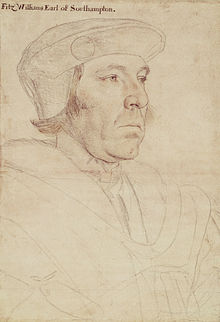William Fitzwilliam, Earl of Southampton
|
The Right Honourable The Earl of Southampton KG |
|
|---|---|

Portrait of William Fitzwilliam, Earl of Southampton, by Hans Holbein the Younger
|
|
| Treasurer of the Household | |
|
In office 1525–1537 |
|
| Preceded by | Sir Thomas Boleyn |
| Succeeded by | Sir William Paulet |
| Personal details | |
| Spouse(s) | Mabel Clifford |
| Mother | Lady Lucy Neville |
| Father | Sir Thomas FitzWilliam |
William FitzWilliam, 1st Earl of Southampton, KG (c.1490, Aldwark, North Riding of Yorkshire – 15 October 1542, Newcastle upon Tyne), English courtier and soldier, was the third son of Sir Thomas FitzWilliam of Aldwark and Lady Lucy Neville, daughter of John Neville, 1st Marquess of Montagu.
FitzWilliam's father died when he was in his infancy, and his mother remarried Sir Anthony Browne Sr. so that FitzWilliam was half-brother to Sir Anthony Browne Jr.. Probably as a result of this connection, he was chosen as a companion for Henry Tudor, Prince of Wales (later King Henry VIII of England) and brought up alongside him. After King Henry's coronation in 1509, he was made a Gentleman Usher and King's Cupbearer, and gradually rose at Court. He began his military career at sea, serving under the Marquess of Dorset in 1512, and Sir Edward Howard in the disastrous second attack on Brest. Unlike his commander, he escaped the debacle, but was badly injured by a crossbow bolt. He recovered sufficiently in time to accompany King Henry VIII into France as an Esquire of the Body, and was knighted on 25 September 1513, the day after the capture of Tournai. In November, he married Mabel Clifford, daughter of Henry Clifford, 10th Baron de Clifford, but the marriage would prove childless.
William FitzWilliam achieved distinction as naval commander, as diplomat, and as government minister. Much of his time as Vice-Admiral (1513–1525) and Admiral were spent keeping the English Channel free from pirates, and he gained praise from Cardinal Wolsey for his initiative in actions against the French. In May 1522, England declared war on France. The Earl of Surrey planned to attack Havre de Grace in June and Morlaix on 1 July, which largely failed due to practical difficulties. Fitzwilliam was appointed as Vice-Admiral, so when the Earl of Surrey abandoned the siege of Brest, he was left on station to blockade the port. The English navy patrolled the coast of Brittany for the next three months, but was unable to score a decisive victory with their Spanish allies. During the autumn, the sea patrol campaign was abandoned with little achieved.
...
Wikipedia
